On detection of a maze of Nazca in Peru
 Bashny.Net
Bashny.Net
rolled 18 images
In the Nazca desert in southern Peru, researchers found a huge maze.
For a long time archaeologists could not say exactly what really is a mysterious structure composed of lines marked on the ground. It is known that in the desert there is a series of lines that add up to the original image.
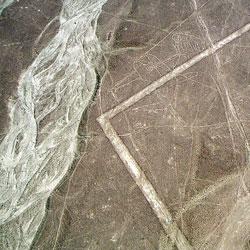
Completely hidden among the flat and featureless landscape of these places labyrinth was discovered after 5 years of hard work of scientists at the Peruvian plain 400 kilometers from the capital city of Peru, Lima. Nazca Lines figures, which are deposited on the surface of the earth in the desert of Nazca with lines, can be seen only from the bird's-eye view. For someone who is in the desert, the lines resemble a long straight road, fleeing into the distance, according to witnesses.
The figures, geometric shapes, images of animals and birds puzzled scientists for the past one hundred years since they were first discovered by modern civilization.
Known for his passion for cutting off the heads of their enemies and collecting them like trophies, the Nazca civilization flourished between about 1 century BC and the 5th century AD. Later, however, this culture went into decline after the Andean Inca Empire began to dominate.
Schematic representation of the labyrinth in the desert of Nazca

Archaeologists from the University of Bristonskogo 5 years had to walk through the desert more than 1,500 kilometers to properly explore the Nazca lines, comparing them with satellite data and shoveled a huge number of artifacts. Archaeologist Clive Ruggles of the University of Leicester came across a maze in 1984, however, carefully examine it was only after 25 years.
The maze consists of 15 turns that make walking on it are removed and approach the big hill before it gets twisted on a spiral track. To pass through the labyrinth to the end, it takes about an hour. Ruggles first to realize that this is a maze and not something else.
View of the labyrinth with a bird's eye

Excellent preserved the edge of the maze of roads suggest that on it were several people in a row. Unfortunately, the importance of this structure and its use by the people of Nazca is a puzzle for scientists.
This maze is likely to have been created around 500 AD. Unlike some of the famous figures of animals, it is not the usual form of this structure does not suggest that it should be viewed from a bird's-eye view.
Rather, it was intended for those who are on the ground and used it for their own, it is not yet known to science, needs. What is clear is that this maze really went the ancient inhabitants of Peru, wrote Ruggles.
According to the researchers, a long walk along the lines of Nazca allowed to collect a lot of interesting information, which allowed a better understanding of the mysterious figures in the desert.
View of the Nazca desert and nearby mountains

Purpose of drawings in the Nazca desert
For a long time all over the world, scientists have puzzled over the fact to understand why the ancient Nazca drew these pictures. Various hypotheses, for example, that the line is an ancient calendar or marking territory for landing alien spacecraft.
They are also associated with the deities of water, saying that they indicate the path and sacred place where people come to worship the gods.
Spider in the desert of Nazca

After studying the shapes and lines, which are placed in an area of 80 square kilometers, Ruggles and his colleagues concluded that bend and quite worn path through the desert were likely to functionality. Conversely, the famous straight lines and geometric shapes have spiritual and ritual significance.
The researchers believe that the essential is the creation of these images, not their subsequent use.
Interesting facts about the labyrinths
1. Labyrinths have been invented by humanity even in ancient times. The earliest labyrinths have been found in the form of rock paintings in the caves. All of them were about the same form they were presented as a series of schematic concentrated near paths connected together and very intricate, with dead ends and surrounding a single center:
Pictures circular labyrinths have been found throughout Europe
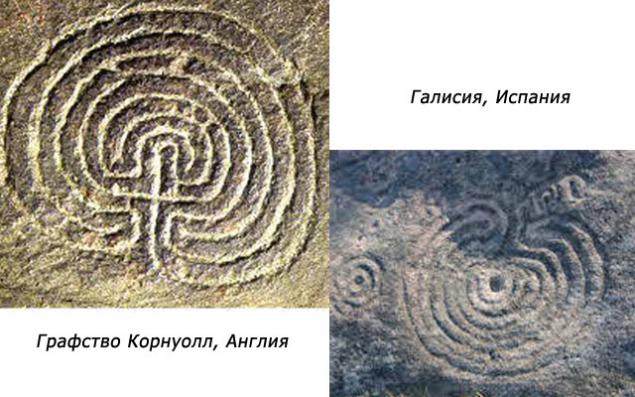
2. In ancient Egypt, there were whole temple complexes, made in the form of stone labyrinths. Labyrinths associated with myths, they were religious rituals that are sacred to the god of the dead Osiris. This intricate passages and corridors of the labyrinth protected by God's enemies, believed by the ancient Egyptians.
Approximately looked ancient labyrinth in Egypt, adjacent to the pyramid

3. The most famous maze in ancient Greece was on the north of the island of Crete. According to the myth, in this labyrinth of the Minotaur monster lived who was later slain hero Theseus. Get out of the labyrinth of Theseus Ariadne helped.
Fight of Theseus with the Minotaur in the labyrinth

4. The victims of the eruption of Vesuvius Pompei had at least 2 of the labyrinth. One of them was in a wealthy house, he was represented as a beautiful skilfully made mosaic that depicts the struggle of Theseus with the Minotaur.
Mosaic in the labyrinth of the Minotaur

5. According to Chinese beliefs, evil spirits can only move in a straight line, so the construction of the maze at the entrance to the house or at the gates of the city had a meaning. Evil Spirit was not able to get inside the room or outside the walls of the city, if you come across a labyrinth.
Streets maze of old Beijing

6. The Nordic nations have built a lot of labyrinths, which according to legend, helped fishermen with their catch, and contributed to the successful return home. To this end, should go through a maze before to go on a fishing trip. On the coast of the Baltic Sea remained about 600 labyrinths built of stone.
Stone maze on the beach
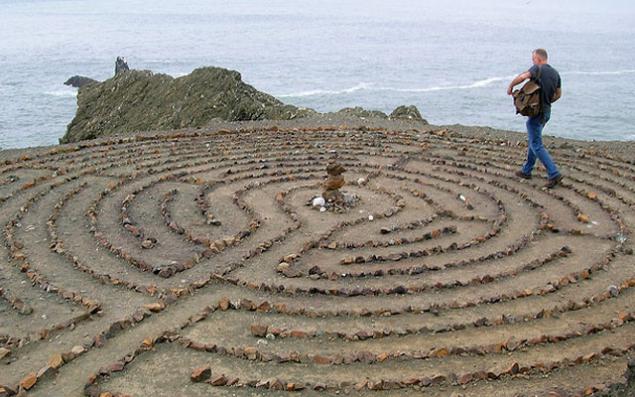
7. An interesting maze can be seen in the French city of Chartres Cathedral on the floor. Similar labyrinths exist in other cathedrals in France and Italy. The Christian world does not mind that this detail was borrowed from paganism. The symbolism of the labyrinth for religious people is a long and difficult road of remorse in order to free from sins.
Beautiful floor of the cathedral in Chartres labyrinth is laid out in the form

8. vengeance Labyrinths are used in landscape design, they are especially common in England. Sod maze in the gardens were used for entertainment or beauty. The largest of such a labyrinth can be found in the county of Essex. The length of its track is 2 kilometers and, according to experts, it is already about 800 years!
One of the English park mazes
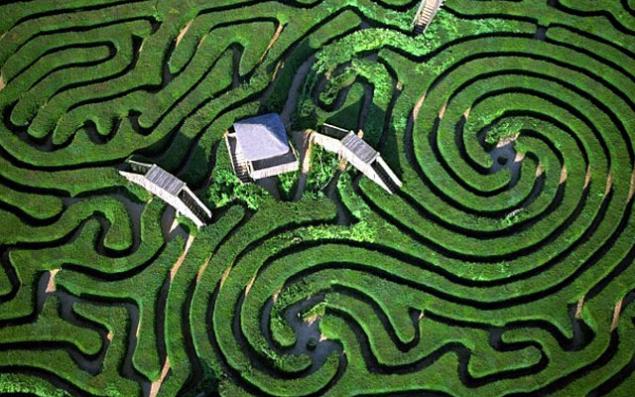
Other interesting decorative maze parkahLabirint heart-shaped, mosaic in the city of Tonkawa, Oklahoma, United States
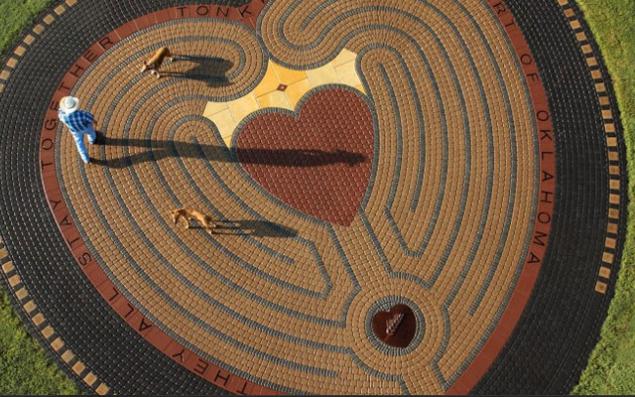
Park labyrinth in Barcelona

Decorative maze Sacred Park in Hawaii
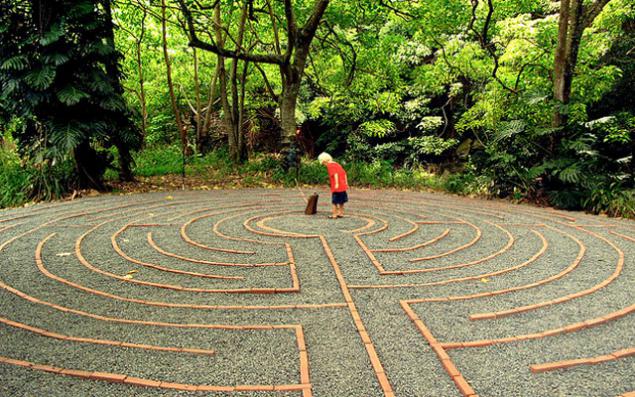
English maze in Canterbury
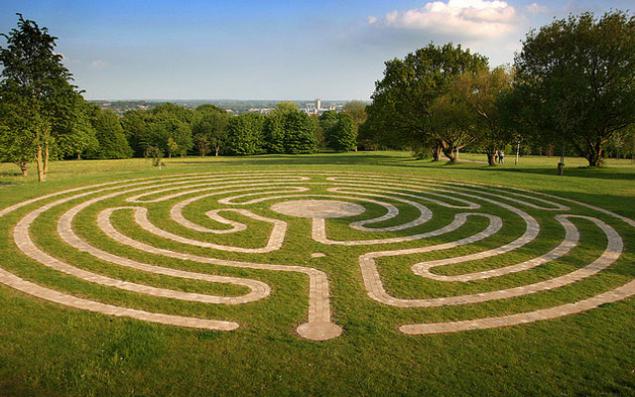
Walk on the English garden-maze: getting lost - simple
hence
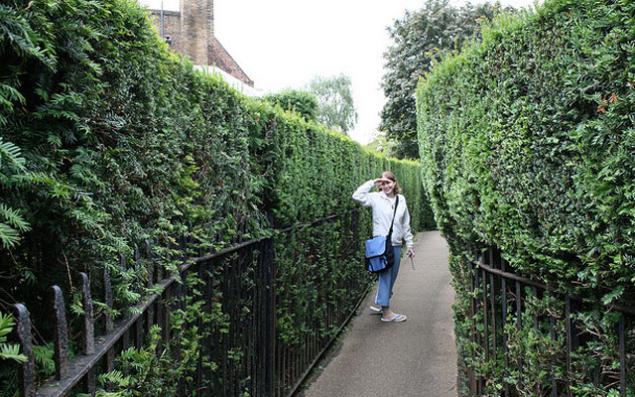
Source:
In the Nazca desert in southern Peru, researchers found a huge maze.
For a long time archaeologists could not say exactly what really is a mysterious structure composed of lines marked on the ground. It is known that in the desert there is a series of lines that add up to the original image.

Completely hidden among the flat and featureless landscape of these places labyrinth was discovered after 5 years of hard work of scientists at the Peruvian plain 400 kilometers from the capital city of Peru, Lima. Nazca Lines figures, which are deposited on the surface of the earth in the desert of Nazca with lines, can be seen only from the bird's-eye view. For someone who is in the desert, the lines resemble a long straight road, fleeing into the distance, according to witnesses.
The figures, geometric shapes, images of animals and birds puzzled scientists for the past one hundred years since they were first discovered by modern civilization.
Known for his passion for cutting off the heads of their enemies and collecting them like trophies, the Nazca civilization flourished between about 1 century BC and the 5th century AD. Later, however, this culture went into decline after the Andean Inca Empire began to dominate.
Schematic representation of the labyrinth in the desert of Nazca

Archaeologists from the University of Bristonskogo 5 years had to walk through the desert more than 1,500 kilometers to properly explore the Nazca lines, comparing them with satellite data and shoveled a huge number of artifacts. Archaeologist Clive Ruggles of the University of Leicester came across a maze in 1984, however, carefully examine it was only after 25 years.
The maze consists of 15 turns that make walking on it are removed and approach the big hill before it gets twisted on a spiral track. To pass through the labyrinth to the end, it takes about an hour. Ruggles first to realize that this is a maze and not something else.
View of the labyrinth with a bird's eye

Excellent preserved the edge of the maze of roads suggest that on it were several people in a row. Unfortunately, the importance of this structure and its use by the people of Nazca is a puzzle for scientists.
This maze is likely to have been created around 500 AD. Unlike some of the famous figures of animals, it is not the usual form of this structure does not suggest that it should be viewed from a bird's-eye view.
Rather, it was intended for those who are on the ground and used it for their own, it is not yet known to science, needs. What is clear is that this maze really went the ancient inhabitants of Peru, wrote Ruggles.
According to the researchers, a long walk along the lines of Nazca allowed to collect a lot of interesting information, which allowed a better understanding of the mysterious figures in the desert.
View of the Nazca desert and nearby mountains

Purpose of drawings in the Nazca desert
For a long time all over the world, scientists have puzzled over the fact to understand why the ancient Nazca drew these pictures. Various hypotheses, for example, that the line is an ancient calendar or marking territory for landing alien spacecraft.
They are also associated with the deities of water, saying that they indicate the path and sacred place where people come to worship the gods.
Spider in the desert of Nazca

After studying the shapes and lines, which are placed in an area of 80 square kilometers, Ruggles and his colleagues concluded that bend and quite worn path through the desert were likely to functionality. Conversely, the famous straight lines and geometric shapes have spiritual and ritual significance.
The researchers believe that the essential is the creation of these images, not their subsequent use.
Interesting facts about the labyrinths
1. Labyrinths have been invented by humanity even in ancient times. The earliest labyrinths have been found in the form of rock paintings in the caves. All of them were about the same form they were presented as a series of schematic concentrated near paths connected together and very intricate, with dead ends and surrounding a single center:
Pictures circular labyrinths have been found throughout Europe

2. In ancient Egypt, there were whole temple complexes, made in the form of stone labyrinths. Labyrinths associated with myths, they were religious rituals that are sacred to the god of the dead Osiris. This intricate passages and corridors of the labyrinth protected by God's enemies, believed by the ancient Egyptians.
Approximately looked ancient labyrinth in Egypt, adjacent to the pyramid

3. The most famous maze in ancient Greece was on the north of the island of Crete. According to the myth, in this labyrinth of the Minotaur monster lived who was later slain hero Theseus. Get out of the labyrinth of Theseus Ariadne helped.
Fight of Theseus with the Minotaur in the labyrinth

4. The victims of the eruption of Vesuvius Pompei had at least 2 of the labyrinth. One of them was in a wealthy house, he was represented as a beautiful skilfully made mosaic that depicts the struggle of Theseus with the Minotaur.
Mosaic in the labyrinth of the Minotaur

5. According to Chinese beliefs, evil spirits can only move in a straight line, so the construction of the maze at the entrance to the house or at the gates of the city had a meaning. Evil Spirit was not able to get inside the room or outside the walls of the city, if you come across a labyrinth.
Streets maze of old Beijing

6. The Nordic nations have built a lot of labyrinths, which according to legend, helped fishermen with their catch, and contributed to the successful return home. To this end, should go through a maze before to go on a fishing trip. On the coast of the Baltic Sea remained about 600 labyrinths built of stone.
Stone maze on the beach

7. An interesting maze can be seen in the French city of Chartres Cathedral on the floor. Similar labyrinths exist in other cathedrals in France and Italy. The Christian world does not mind that this detail was borrowed from paganism. The symbolism of the labyrinth for religious people is a long and difficult road of remorse in order to free from sins.
Beautiful floor of the cathedral in Chartres labyrinth is laid out in the form

8. vengeance Labyrinths are used in landscape design, they are especially common in England. Sod maze in the gardens were used for entertainment or beauty. The largest of such a labyrinth can be found in the county of Essex. The length of its track is 2 kilometers and, according to experts, it is already about 800 years!
One of the English park mazes

Other interesting decorative maze parkahLabirint heart-shaped, mosaic in the city of Tonkawa, Oklahoma, United States

Park labyrinth in Barcelona

Decorative maze Sacred Park in Hawaii

English maze in Canterbury

Walk on the English garden-maze: getting lost - simple
hence

Source:
Tags
See also
10 amazing scientific experiments that happened by chance
Solar energy - a huge, inexhaustible and clean resource
The flea from a piece of amber 20 million years found plague Bacillus
Cancer has always been with us: the progression of the disease throughout the history of mankind
Biological RHYTHMS: circadian rhythms of BODIES
Why don't I tell mom about your problems
Tunnels lost civilizations
My trip to Peru.
Tales of underground tunnels

















